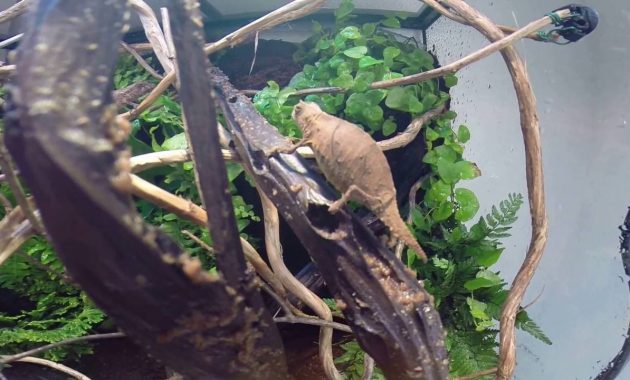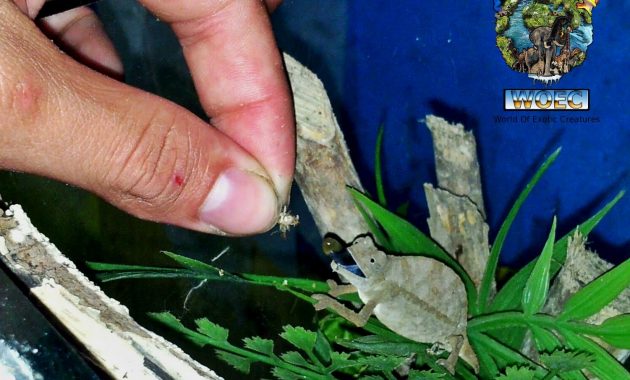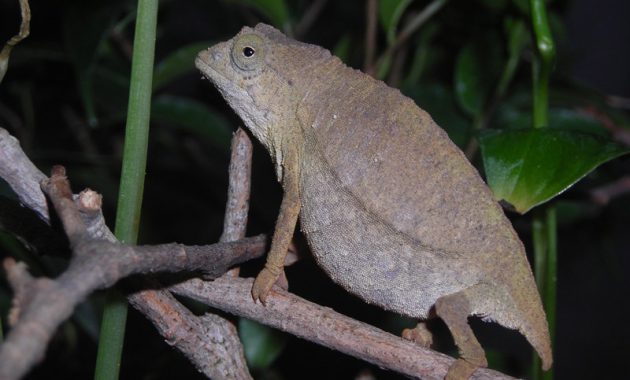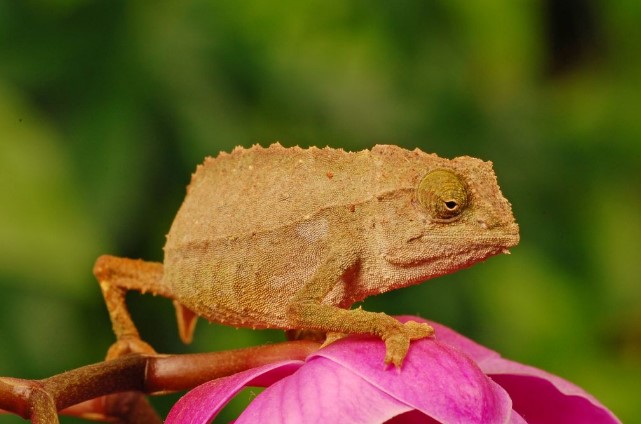Pygmy chameleons, or rhampholeon brevicaudatus, are a small species of rhampholeon reptiles that are native to Tanzania.
This type of chameleon is considered a great “starter” pet for someone who is interested in caring for a reptile but who has little or no experience at the task.
Pygmy chameleons grow to a maximum size of about three inches in total length and can live anywhere from two to five years of age.
This species does have color changing abilities, although they are usually used to show emotion, catch a mate, or to scare off potential predators.
Let’s take a look at some of the aspects necessary to properly care for a pygmy chameleon.
Tank Requirements

One of the reasons that pygmy chameleons are recommended for people who are inexperienced in caring for reptiles is because the pygmy’s habitat doesn’t require a great deal of maintenance.
The general rule to go by when choosing a tank for this species is three chameleons per 20 gallon tank. If only one is being kept, a 10 gallon tank will be sufficient.
UV lighting is not required; one can simply use halogen or fluorescent lighting for basking purposes.
If a basking light is provided, it is important to also include a water dish large enough for the chameleon to climb into. The water should be replaced daily or as needed.
A fish aquarium is not suitable for a chameleon as it lacks the proper amount of airflow. A mesh screen or covering will do nicely to allow plenty of ventilation without allowing the chameleon the opportunity to escape.
The temperature of the aquarium should be kept between 70 and 80 degrees F, although the aquarium should not be kept near a window or in direct sunlight as this can easily cause the pygmy chameleon to overheat and even die.
Landscaping

Having the proper landscape within the tank is essential to making the pygmy feel comfortable and remain healthy. This is the part where a potential pygmy owner can get really creative!
One should start off with a basic foundation of about two inches of natural potting soil and peat moss, mixed at 50/50 percent. A thin layer of wet sphagnum moss to coat the top will do nicely.
The landscape can then be accentuated with various plants. Ferns and pothos are well loved by pygmy chameleons and can really spruce up the environs.
Pieces of wood and large rocks will also help to make the chameleon’s new home much more natural.
Related Post: Fire Ant Bites
Feeding and Watering

Knowing what and how often to feel a pet is an extremely important element of caring for any pet, and especially so for reptiles.
Fortunately, the pygmy chameleon does not as often as other chameleons and its food can be easily obtained.
Live prey is the best for pygmies, as they aren’t very receptive of freeze-dried foods. Crickets, mealworms, fruit flies, and nymph roaches are some favorites of the pygmy chameleon.
Many pygmy owners claim that as long as the prey is life and small enough for the pygmy to eat, it will give it a try!
When trying out new foods, one should monitor the way the pygmy accepts or refuses the food. This will be a good indicator as to whether the food is palatable to the pygmy.
As with any animal, the chameleon cannot survive without water. Pygmy owners often report that their chameleon won’t drink water from a dish or watering spout.
The best way to get around this is to mist the plant leaves in the enclosure about three times a day. The chameleon will use this water for drinking and the water will also prove to add to the humidity of the tank.
Handling and General Maintenance

Handling the pygmy straight away isn’t a good idea. Moving to a new environment is a very stressful ordeal and the chameleon should be allowed time to settle in to his new home.
After a few weeks and even months, the chameleon can be handled for small periods of time. This will get him used to the idea of being handled.
The length of time and frequency of which the chameleon is handled should be gradually increased until he is comfortable with being touched.
Some never become completely comfortable, in which case it is probably best to simply leave it as a “look-but-don’t-touch” pet.
As far as general maintenance goes, one needs to simply maintain the plants within the enclosure and ensure that the water bowl (if a basking light is provided) has fresh water available.
Water should be misted onto the plants and onto the chameleon itself about two or three times a day.
As long as the temperature is regulated and the previously-mentioned conditions are met, the pygmy chameleon should have a happy and long life!

Thanks for all the information. It was very helpful. Some other thoughts…
Chameleons in general are definitely not for beginners. Even if you had a turtle or two, you don’t seem to have any experience with lizards. Pygmy chameleons, especially, are very fragile. Handling them is only done rarely. All chameleons need proper air circulation by vertical/tall terrariums that compromise mesh design and not glass, a humidifying device that provides morning dew for them to drink from the enclosure decor, and a host of other strict requirements. They are easily stressed, and even the most long lived captive specimens kept by experts rarely exceed seven years, if that amount of time. Overall, chameleons species typically require advanced care, with a few being intermediate.